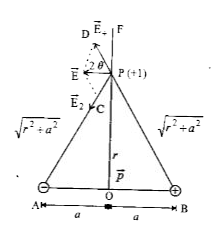Derive a electric field intensity at a point on equatorial line of an electric dipole.
Consider an electric dipole AB of length 2a. Let P be the point on the equatorial line at a distance r from the centre of the dipole.
Electric field intensity at P due to +q carge is given by
→E1=14πɛ0qBP2along PD
→E1=14πɛ0q(√r2+a2)2along PD
→E1=14πɛ0qr2+a2along PD
Electric field intensity at P due to −q given by
→E.2=14πɛ0qAP2along PC
→E.2=14πɛ0q(√r2+a2)2along PC
∴ ∣∣→E1∣∣=∣∣→E2∣∣=14πɛ0q(r2+a2)
→E1and→E2, are inclined at an angle of 2θ. So, using parallelogram law, the net electric field intensity can be measured.
∴ √E21+E22+2E1E2cos2θ
=√E21+E21+2E21cos2θ [∴E1=E2]
=√2E21+2E21cos2θ
√2E21(1+cos2θ)
=√2E21×2cos2θ [∴(1+cos2θ=2cos2θ)]
E=2E1cosθ
∴ E=2×14πɛqr2+a2cosθ ...(1)
Now from Delat OAP
cosθ=a√r2+a2
From equation (1)
∴ E=2×14πɛ0qr2+a2×a√r2+a2
E=q×2a4πɛ0(r2+a2)3/2
Now q×2a=p (dipole moment)
E=p4πɛ0(r2+a2)3/2along(-a)axis ...(2)
In vector form
→E=−→p4πɛ0(r2+a2)3/2
The direction of electric field →E is opposite to the direction of the dipole moment of electric dipole.
We know that
For an ideal dipole a << ∴ a2can be neglected as compared tor2.
∴ from eq. (2)
E=p/(4 pi varepsilon_(0)(cancel(r^(2)))^(3//cancel2))
E=p4πɛ0r3along(−)x-axis
∴ E∝1r3

Similar Questions
(i) Derive the expression for electric field at a point on the equatorial line of an electric dipole.
(ii) Depiet the orientation of the dipole in (i) stable, (ii) unstable equilibrium in a uniform electric field.View SolutionDerive the expression for electric field at a point on the equatorial line of an electric dipole.
(b) Depict the orientation of the dipole in (i) Stable (ii) unstable equilibrium in a uniform magnetic fieldView SolutionDerive the expression for the electric potential at any point along the axial line of an electric dipole.
View SolutionDeive an expression for the electric field at any point on the equatorial line of an electric dipole.
View SolutionThe electric potential at a point on the equatorial line of a electric dipole is
View SolutionWhat is the ratio of electric field intensity at a point on the equatorial line to the field at a point on axial line when the points are at the same distance from the centre of the dipole ?
View SolutionDefine electric dipole moment. Is it a scalar or a vector ? Derive the expression for the electric field of a dipole at a point on the equatorial line of the dipole.
View SolutionWhat is the ratio of electric field intensity at a point on the equatorial line to the field at a point on axial line when the points are at the same distance from the centre of the dipole ?
View SolutionFor an electric dipole, the field at a point on the equatorial line and the dipole moment are
View SolutionDerive an expression for intensity of electric field are a point in broadside position or on an equatorial line of an electric dipole.
View Solution

